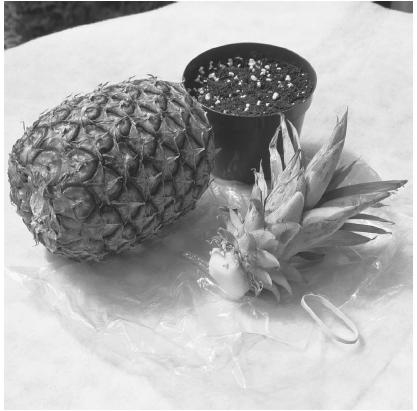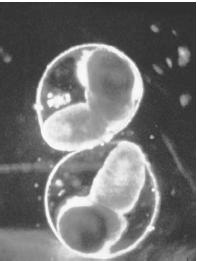Reproduction - Real-life applications
Examples of Asexual Reproduction
As we noted earlier, bacteria, blue-green algae, most protozoa, yeast, and flatworms all reproduce asexually, as do mosses and starfish. (The last actually reproduce both sexually and asexually by means of alternation of generations, discussed later.) The products of asexual reproduction are known as clones—an example of the fact, discussed in Genetic Engineering, that cloning and the concept of clones are not as new as one might imagine. (See that essay for much more about artificial cloning.) A starfish can regenerate and eventually produce a whole new organism from a single severed appendage, while flatworms divide in two and regenerate to form two new flatworms. This formation of a separate organism is obviously much more complex than the simple splitting of single bacteria cells, but it is still a form of asexual reproduction.
VEGETATIVE PROPAGATION.
Strawberries reproduce by forming growths called runners, which grow horizontally and generate new stalks. At some point, the runner decomposes, leaving a new plant that is a clone of the original. This is an example of vegetative propagation, a term for a number of processes by which crop plants are produced asexually. Vegetative propagation is used for such crops as potatoes, bananas, raspberries, pineapples, and some flowering plants. Its advantage to farmers is that the crops will be more uniform than those grown from seed. Furthermore, some plants are difficult to cultivate from seed, and the vegetative propagation of those plants makes it possible to grow crops that otherwise would not be available for commercial marketing.
In reproducing potatoes through vegetative propagation, farmers plant the so-called eyes to produce duplicates of the parent. With banana plants, the farmer separates the suckers that grow from the root of the plant and plants them. The farmer raising raspberry bushes bends the branches and covers them with soil, whereupon a process not unlike that of the runner growth of mosses takes place: the branches eventually grow into a separate plant, with their own root system, and ultimately can be detached from the parent plant.
Between Asexual and Sexual
The example of vegetative propagation suggests that there is not a sharp dividing line between sexual and asexual reproduction—that is, that many organisms can reproduce either way. This is true even of humans, who, in theory, could be cloned, though the technology to do so—let alone resolution of the ethical issues of the procedure—lies in the far distant future. (See Genetic Engineering for more on this subject.) Even humans, however, can use external fertilization, which is sexual reproduction without sexual intercourse (see Sexual Reproduction).
Plants go through a process known as alternation of generations, in which they alternate as sexual and asexual reproducers, or gametophytes and sporophytes, respectively. In the asexual stage, the sporophyte produces diploid reproductive cells called spores, which develop into gametophytes. These gametophytes produce haploid gametes, which then unite sexually to form a diploid zygote that grows into a sporophyte. In

At one phase in the alternation of generation for mosses, for instance, male and female moss plants grow from spores. Male moss plants produce sperm cells, which, when the moss receives rainfall, are able to propagate because they have a medium (water) in which to move. They fertilize the female plants, producing zygotes. The zygote grows on top of the female moss plant, which helps to store moisture and thus provides a hospitable environment in which the zygote can develop. The zygote eventually produces haploid spores, which it releases into the air. These tiny spores, carried by the wind, float away from their point of origin until they come to rest, and soon the cycle begins once again.
PARTHENOGENESIS.
There are also organisms, including bees, ants, wasps, and other insects, that reproduce in a way that is neither fully sexual nor asexual. This is parthenogenesis, a type of reproduction in which a gamete develops without fertilization. In other words, a sex cell is reproduced without actual intercourse between male and female. The gamete is almost always female—a fact indicated in the name itself, which comes from parthenos, Greek for "maiden."

The Parthenon in Athens, like the city itself, is named after the goddess Athena (also called Minerva), who was known by the nickname Parthenos. She is said to have been born fully formed, having sprung from the head of her father, Zeus, dressed in armor and ready for battle. Thus, her own birth was a form of parthenogenesis, a word whose second half (a name well known from the Bible) means "beginning."
Pollen and Pollination
Pollen is a fine, powdery substance consisting of microscopic grains containing the male gametophyte of certain plants that reproduce sexually. These plants include angiosperms, a type of plant that produces flowers during sexual reproduction, and gymnosperms, which reproduce sexually through the use of seeds that are exposed and not hidden in an ovary, as with an angiosperm. Pollen is designed for long-distance dispersal from the parent plant, so that fertilization can occur. Pollination is the transfer of pollen from the male reproductive organs to the female reproductive organs of a plant, and it precedes fertilization. In other words, pollination is the equivalent of sexual intercourse for seed-bearing plants. Actually, cross-pollination, or the transfer of pollen from one plant to another, would perhaps be analogous to sexual intercourse in animals. Pollination occurs in seed-bearing plants, as opposed to the more primitive spore-producing plants, such as ferns and mosses. Gymnosperms, such as pines, firs, and spruces, produce male and female cones, whereas angiosperms produce flowers containing a male organ called the stamen and a female organ called the pistil. Both types of plants rely on insects and other creatures to aid in the pollen transfer.
DARWIN'S MOTH.
The German physician and botanist Rudolf Jakob Camerarius (1665-1721) was the first scientist to demonstrate that plants reproduce sexually, and he pioneered the study of pollination. One of the scientists influenced by his work was the English naturalist Charles Darwin (1809-1882), who discussed the subject in The Various Contrivances by which Orchids Are Fertilized by Insects (1862). Darwin wrote this book partly to support the ideas on evolution presented in his much more well known book Origin of Species (1859). In Various Contrivances, he suggested that orchids and their insect pollinators evolved by interacting with one another over many generations.
As an example, he discussed Angraecum sesquipedale, an orchid native to Madagascar. Darwin had not seen the plant in its native habitat, however; he had looked only at its dried leaves. The white flower of this orchid has a foot-long (30 cm) tubular spur with a small drop of nectar at its base, and from observing this, he hypothesized that the orchid had been pollinated by an insect with a foot-long tongue. This hypothesis, he wrote, "has been ridiculed by some entomologists," or scientists who study insects. After all, no such creature had been found in Madagascar. But then, around the turn of the nineteenth century—some two decades after Darwin's death—it was found. A Madagascan moth was discovered that had a foot-long tongue that uncoils to sip the nectar of A. sesquipedale as it cross-pollinated the flowers.
PLANTS AND THEIR POLLINATORS.
Angiosperms and gymnosperms are discussed in Ecosystems and Ecology, where each is compared in terms of its degree of adaptation to its environment. Angiosperms seem to be the hands-down winner: by enlisting the aid of insects and other pollinators, they manage to pollinate much more efficiently than gymnosperms, which have to produce vast quantities of pollen for each grain that reaches its target. Typically, pollination benefits the animal pollinator by supplying it with sweet nectar and, of course, benefits the plant by providing direct transfer of pollen from one plant to the pistil of another plant. For this reason, specific plant and animal species have developed a relationship of mutualism, a form of symbiosis in which each participant reaps benefits (see Symbiosis). In many cases, plant and pollinator have evolved together, and it is possible to determine which animal pollinates a certain flower species simply by studying the morphologic features (shapes), color, and odor of the flower.
For example, some flowers are pure red, or nearly pure red, and have very little odor. In most such situations, the pollinator is a bird species, since birds have excellent vision in the red region of the spectrum but a rather undeveloped sense of smell. It so happens that Europe, which has no pure red native flowers, also has no bird-pollinated native flower species. Not all bird-pollinated flowers are red, but they are all characterized by striking, and sometimes contrasting, colors that readily catch the eye. Examples of plants pollinated by birds include the cardinal flower, the red columbine, the hibiscus, the eucalyptus, and varieties of orchid, cactus, and pineapple.
Some flowering plants have a very strong odor but are very dark, or at least drab, in color. These flowers and plants—examples include the saguaro cactus, century plant, or cup-and-saucer vine—are often pollinated by bats, which have very poor vision, are typically active during the night, and have a very well developed sense of smell. The flowers of many plant species are marked with special pigments called flavonoids, which absorb ultraviolet light and appear to direct the pollinator toward the pollen and nectar. These pigments are invisible to humans and most animals, but bees' eyes have special ultraviolet photoreceptors that enable the bees to detect patterns and so pollinate these flowers.
Comment about this article, ask questions, or add new information about this topic: